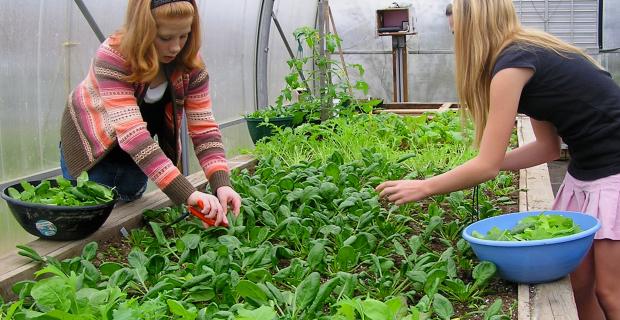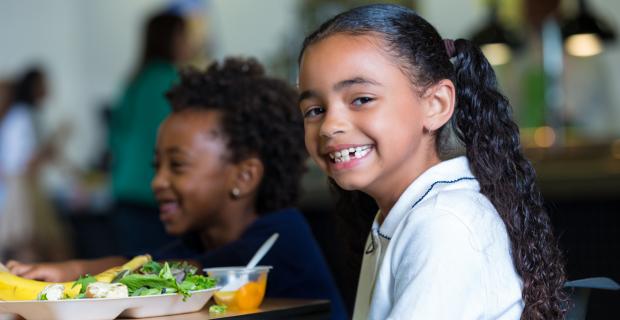Voters Tax Selves for Farm-to-School Produce

In 2007, voters in Davis, California, voted overwhelmingly to tax themselves to provide more fresh fruits and vegetables for school meals — the first district in the country known to have taken that step.
This victory, the result of eight years of efforts by parent activists, illustrates the value of building community support for change in schools.
The tax measure called for spending $70,000 a year to improve nutrition at schools by providing students with farm-fresh produce. Like many other communities, Davis has had to supplement public school funding with "parcel taxes." (California's famous 1978 Proposition 13 limits taxes based on the value of property, but permits local voters to approve per-unit property taxes.) These measures usually support class size reduction and programs such as music and art. Adding school meals was a breakthrough. Because achieving the two-thirds vote required for parcel taxes is difficult, districts are leery about introducing new items when the taxes are renewed; Davis officials inserted the provision only after a poll showed school food atop the items voters would support.
The odyssey leading to the tax vote began in 1999 when two Davis mothers, Ann M. Evans and Page O'Connor, discovered Lunchables being offered as snacks on a first-grade field trip they were chaperoning. The prepackaged treats — high in calories, fat, and sodium — "were grotesque," recalls Evans. "We were horrified, and decided we were just going to change it, then and there. It was like we drew the line in the sand. If industry and the marketplace were going toward Lunchables, that was beyond what we could tolerate. The school district needed to be providing other things."
Evans and O'Connor began comparing notes with another mother, Deb Bruns, who had been executive director of the Community Alliance with Family Farmers. "We were all interested in nutrition, recycling, and gardens," says Evans. "But most of us were packing our kids' school lunches to make sure they got what we wanted them to have."
Having decided to change rather than bypass school food, the moms recruited other citizens with deep connections within the Davis community. Evans, for instance, was a former mayor of Davis and a founder of the Davis Food Co-op and the Davis Farmers Market, and was serving as a special assistant to the California Superintendent of Public Instruction. Other core members of the group, which called itself the Davis Farm to School Connection, included the director of the Davis Farmers Market, nutrition educators, the district school garden coordinator, PTA presidents, and researchers from the University of California's Sustainable Agriculture Research and Education Program.
The group told the Davis school superintendent, "We'd like permission to work in your schools. We'll give it ten years." It had taken ten years to get the Food Co-op off the ground, and Evans reasoned that this project would take as long. They had let administrators know that they did not plan to try to overturn the system if they didn't get their way immediately. "We were all professionals," Evans reflects. "We were all mad moms too, but professional courtesy was our overriding modus operandi." At the same time they had made it clear that they had committed for the long term, and would not go away at the first discouragement.
The Farm to School Connection modeled its first program, the "Crunch Lunch," on the farm-to-school salad bars pioneered in Santa Monica by Rodney Taylor. They raised start-up money, hired a coordinator, connected with schools that had gardens, and started salad bars featuring food from the Davis Farmers Market.
In spite of having formed primarily to change food, the Farm to School Connection seized an early opportunity when funding became available to initiate a recycling program as well. "You've got to follow those opportunities when they arise," says Deb Bruns. The group's Strategic Plan shows its sophisticated understanding of school systems: "A healthy school environment is a complex property of the whole system. Health does not reside in any of the individual programs, such as garden-based learning, fresh local foods in the school lunch program, or recycling and waste reduction. A healthy school environment has properties that the programs do not have. It is the aggregate of these connections."
Their whole effort, in fact, can be seen as an exercise in making and taking advantage of connections. Relationships that members had made with the Alameda County Waste Disposal Authority led to the grant that launched the recycling program. That program, Recycling Is Simply Elementary (RISE), provides materials and workshops to help teachers make curricular connections to recycling. The program requires collaboration with school custodians. (As part of its network building, the Farm to School Connection holds an annual lunch, at which it invites feedback from the custodians. After four years, the district saw the value of these sessions, and paid for custodians' time in order to convene its own meeting — the first time that the district had met with all its custodians.)
RISE saved the district money by cutting elementary school waste in half. After three years, the Farm to School Connection documented these savings to the district's satisfaction, leading to a breakthrough agreement. RISE had been sustained by Farm to School Connection fundraising. The district agreed to fund the program by remitting half of the money it saved, the first time it had done this for a program run by an outside group. The program now pays for itself while generating additional income for the district's general fund, an important achievement in making the program sustainable. Another sign of success: when elementary school students who had participated in RISE graduated to a middle school with no recycling program, they began asking, "Where do we sort our garbage?" Told that the school had no program, the kids started one.
Turning toward the Community
Between 2001 and 2006, the Farm to School Connection raised more than $400,000 for Davis school food programs. By 2005, the district had more than tripled its fresh produce budget and increased purchases from local growers from zero to 52 percent. Still, the district business office concluded that the salad bar program could not be sustained after the grant that had underwritten the necessary extra labor expired. It was cut back to one day a week and then replaced with prepackaged salads.
The Farm to School Connection believed that the money problems resulted from larger financial issues within the district but could not prevent the closing of the program. Maintaining an effective relationship between the district and the Farm to School Connection, which had no formal role or authority, proved an ongoing challenge. As much as the district welcomed the money the Farm to School Connection raised, some members felt they were regarded as "fussy, over-involved meddlers" trying to force their vision and priorities on the district. "We were trying to push the program on the district without 100 percent buy-in," says longtime member Jamie Buffington. "As long as we were pushing it and running it, they didn't own it" and so were willing to shut it down.
In the face of such setbacks, members of the group relied on each other for support, another important lesson for change agents. "When we've been discouraged," says Buffington, "we've taken a step back and done some fun things, like getting together during the holidays, drinking champagne, eating good food, and enjoying each other's company. Sometimes when you relax, that's when the big thoughts come. When one person is low and thinks they can't make it through another day with this stuff, someone else will come and be supportive, and enlighten everyone."
One "big thought" involved a strategic decision to change direction. Instead of trying to persuade district administrators, they decided in 2006 to turn and face outward — to concentrate on building community support for their ideas. The Farm to School Connection became a project of the Davis Farmers Market Foundation. They also recognized that building community support required easy-to-understand messaging. "It was too difficult to explain what the Davis Farm to School Connection was," recalls Evans. "We thought if we could simply say, 'It's the Davis Farmers Market program in the schools,' the thousands of people who came to the market every Saturday would get it immediately." Having enough people "get it" would be necessary to take their program to the voters.
They also began laying the groundwork for the 2007 parcel tax vote by generating support within the school board. "It took us a long time to figure out that the school board had never really eaten a school lunch," says Bruns. "So whenever we came to board meetings, we'd bring salads, farmers' market baskets, or whatever. A lot of that kind of education needs to go on." They arranged for school board members to address conferences, such as a statewide summit on student health and school food cosponsored by the Center for Ecoliteracy. These board members later became leaders in the parcel tax effort.
The Farm to School Connection also invited the school food service staff to join chefs from leading local restaurants on a "Chefs' Walk" promoting farmers' market products. Treating the food services staff as peers with prominent local chefs helped them see themselves as valued food professionals rather than as "lunch ladies."
Local chef and nationally acclaimed cookbook author Georgeanne Brennan offered a class to help the staff become excited and enthusiastic about cooking from scratch. "They loved tasting each other's creations and realizing that every single thing you put in contributes to the flavor," Brennan says. One result from the class was "Soups from Scratch," which became a weekly feature at Davis schools. With no Crunch Lunch, Brennan developed seasonal taste profiles to incorporate tastes and scents of the seasons using local ingredients throughout the whole menu. This program succeeded, Evans believes, because the food service staff saw the Farm to School Connection as offering something desirable rather than asking them to do something. "That's a key concept," says Evans. "When you're offering someone something you want, it's hard to see when they don't want it."
Following passage of the parcel tax, a memorandum of understanding with the district assigned the Farm to School Connection the formal relationship it had lacked before. The two organizations committed to collaborating on mutual goals, including purchasing 60 percent of school lunch produce from local growers, having district staff rather than volunteers manage the waste reduction program, and creating a teacher-designed curriculum with gardens, waste reduction, and the cafeteria as contexts for teaching core academic standards. The Farm to School Connection is also designing an exit strategy for itself, something change agents often fail to do. "Our long-term objective is the district's full ownership of the program," says Evans. "We still plan to be involved, but we imagine ourselves more like the football booster club. We'll raise money to support the district, but we won't try to tell them how to play the game."
This essay is adapted from Michael K. Stone, Smart by Nature: Schooling for Sustainability (Watershed Media/University of California Press, 2009).




